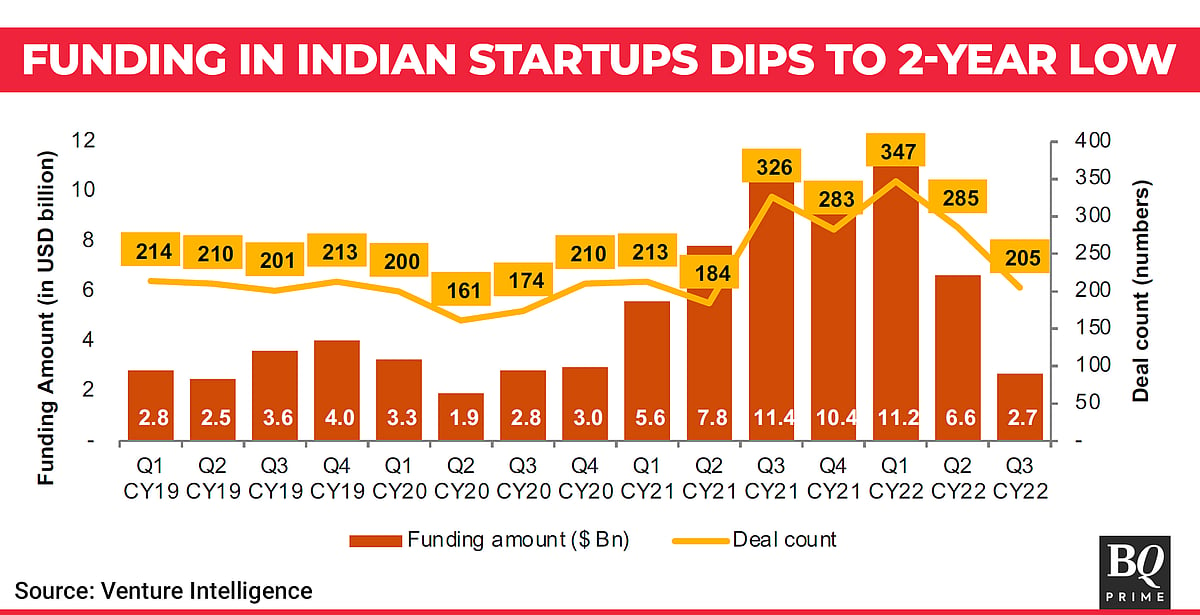Startup Funding In India Plunges To Pandemic Lows In Q3 2022
Funding winter continues in India’s startup ecosystem as well as globally, and it’s uncertain until when this will last.

Startup funding in India dipped to $2.7 billion during the July-September quarter, returning to pandemic lows, according to PwC India.
“Funding winter continues in India’s startup ecosystem as well as globally, and it’s uncertain until when this will last,” said Amit Nawka, startups leader and partner, deals at the consultancy services provider. “Although it has been argued that there is substantial committed capital waiting to be deployed, it is becoming clearer that selectivity in dealmaking will increase, with a focus on path-to-profitability, especially in growth- to late-stage companies.”
The sequential decline in funding activity stood at 59% by value, down from $6.6 billion in the April-June quarter. The drop was also in terms of volume, with the number of deals coming down from 285 to 205—down 28%.

“Funding in growth and late-stage deals continued to decline, with an average ticket size of $13 million in Q3,“ Nawka said. “While decline in funding is noted across all stages of investment—early, growth and late—the decline has been the least in early-stage deals, where the average ticket size is $4–5 million.”
The funding winter in India has manifested in the form of mass layoffs, plunging valuations for startups lined up to go public and founders renewing focus on the path to profitability.
Edtech startups such as Byju’s, Vedantu, FrontRow, Toppr and Unacademy have all resorted to layoffs, while some of India’s largest startups such as Cars24, Ola, Oyo and Droom have deferred plans to go public amid falling valuations.
Fintech and software-as-a-service startups, according to PwC, attracted the most capital in the three months ended September, in line with previous quarter trends.
The top five sectors—fintech, logistics and autotech, SaaS, media and entertainment, and edtech—contributed about 67% of funding activity.
The key deals across these were sectors were:
Fintech: OneCard, EarlySalary, Fi.Money and Jai Kisan
Logistics and autotech: Yulu Bikes, Shiprocket and XpressBees
SaaS: CleverTap, Skyroot, PriceLabs
Media and entertainment: Kuku FM
Edtech: UpGrad, Sunstone
“We expect more capital to be available from January 2023. It, however, is almost certain that selectivity in dealmaking will increase, and startups will have to prove a path to sustainable growth. IPOs will also resume from 2023, and pricing is expected to be far more moderate as well,” said Pranav Pai, founding partner at 3one4 Capital.
“The demand for Indian market leaders and category creators will continue over the medium and long term as markets recover from these corrections next year,” Pai said.
Dry Powder Aplenty
According to PwC India, there is around $562 billion worth of dry powder lying around for venture capital and private equity firms, globally.
Dry powder refers to the amount of committed but unallocated capital a firm has on hand. It is an unspent cash reserve that is waiting to be invested.
“The buildup of dry powder is due to a market pullback by VC funds that are being picky about their investments. The focus is on companies that have strong unit economics and a path to profitability,” it said.
The large amount of dry powder, it said, is an indicator that strong investment cycles could be seen ahead.
“Indian VC can be at a thriving level even at $10 billion of capital invested per year. 2021 was $38 billion, and there is plenty of froth there that won’t be missed,” said Rahul Chandra, co-founder at Arkam Ventures. “We estimate global committed capital of more than $20 billion raised for India not yet deployed. We expect this capital to trickle back to Indian startups by the second half of 2023.”

